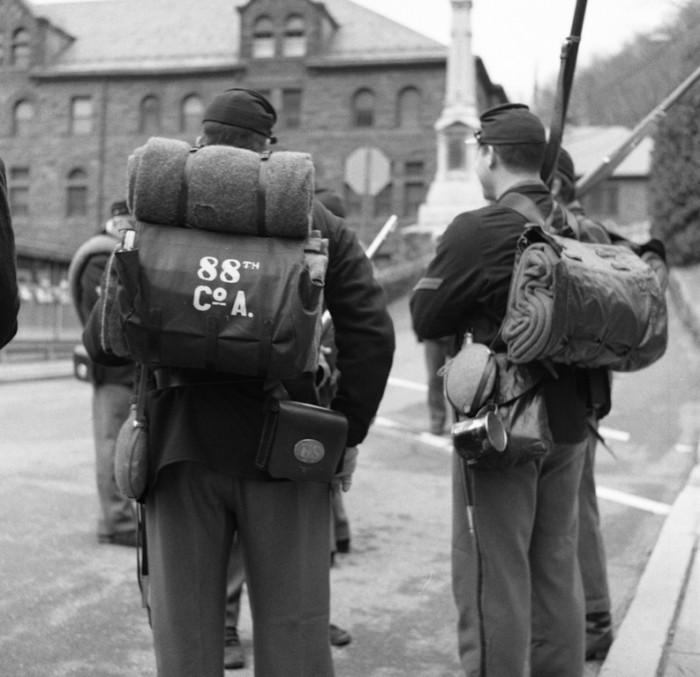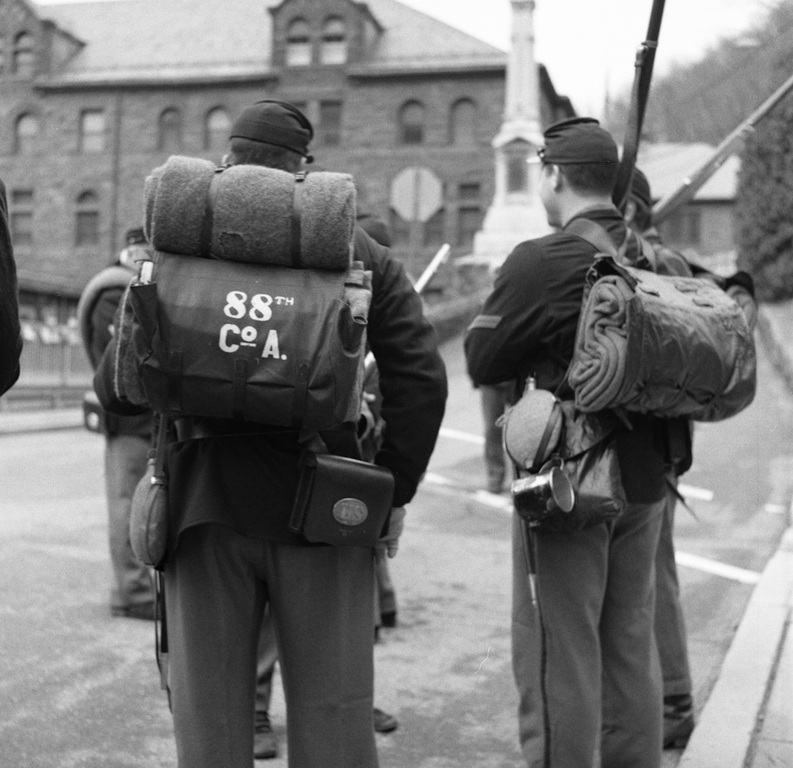88th
Shot on Ilford HP5, EI 800, at the Jim Thorpe St. Patty’s Day parade. I’ll have a few more shots of these guys. The insignia on this guy’s backpack really struck me as powerful in B&W – they even offered to turn around and pose, and I turned ’em down.
But back to my quick comment yesterday: I’ve been contemplating the question “Is film ‘better’ than digital?”
Since I started shooting film, I hear this a lot. “Film is so much
better than digital!” says the die-hard film addict that I ran in to
on the street. I believe there are ways in which that’s true. Medium
and large format negatives yield exceptionally high resolution, for
example. But random film nut guy’s reasoning is the one that I hear
the most often: “more thought goes in to shooting film, and
concentrating on it means you get better pictures.” At that point I
start nodding and making general agreement noises, but I’m not
actively continuing the conversation. I don’t generally buy it, but
I’ve never had any information to back up my gut instinct. Now that
I’m pretty deep in to film, I wondered if it was true and, like any
science-minded individual would do, I compiled some statistics on my
shots to help me understand the arguments.
My “hit rate” for digital is usually around 10% – one of every ten
shots I take is one that I like enough to post-process. My digital
shots in Jim Thorpe this year are right on the money: 10.1% (495 shots
taken, 50 that I’ll finish processing).
On the film side of the camp, I shot 7 rolls of 120 (85 frames). Of
them, my first-round picks are way up: I’m processing 35 of them
(41.7%). You might read that as “I’m four times more likely to take a
good shot with film as digital.” So the “common wisdom” of “with
digital you take more crappy shots because you spend less time
focusing on what you’re doing” sounds plausible.
I spent some time thinking about this after generating my
statistics (those train rides home from work are great thinking
time). It occurred to me that there’s a flip side. In the digital
world, I average four exposures for every shot that I see (leaning on
the shutter release). In Jim Thorpe, I count 130 individual scenes
over 495 shots. It’s not because I’m lazy and don’t want to take the
time to compose the shot. I do it because I can, and
because it improves the likelihood of having successfully
gotten the shot that I visualized. I don’t have to worry (as
much) about models that blinked at the wrong moment or whatever other
trivial nuance I might have missed during the shooting; at my leisure,
I can go back and pick through the three or four and see if there are
any substantial differences between them that might make or break the
shot. Or, I can see some candid shot underway, start shooting it while
I pull the camera up, and find out in post whether or not I “got it”
in the dozen shots I fired off. Sometimes this yields really
fascinating blown exposures that I like for artistic
reasons. Allowing yourself to make mistakes adds to the creative
process!
The only reason I don’t do the same with film is that I
can’t. (And this is probably a good reason for me to
never shoot 35mm with a motor drive advance – I’d spend too much time,
or too much money, developing…)
In the digital case, this means that I’ve got 3-4x as many
“keepers” than what I actually process, because they’re identical (or
nearly identical). Filtering out the dups from the Jim Thorpe set
brings me back to a hit rate of… 38.5% (50 of 130).
So: yes, my shooting style is different with digital than it is
with film. I take more “chances” with digital, and my film shots are
perhaps a little bit “safer”. But the next time some old fart tries to
tell me that “you shoot better pictures with film because you worked
harder to compose the shot,” I can tell him that, at least for me, his
argument doesn’t hold water. I shoot a similar percentage of
good shots with either film or digital.
And now I’ll get off your lawn.
Other perspectives and thoughts on the similarities and differences between shooting Film and Digital are, of course, welcome!


I agree with the premise — if you slow down and think about it, you get better results. I am more often happy with my results when I shoot from a tripod, because it slows me down. I enjoy the process more. I don’t have the self-discipline to slow down when I’m shooting handheld (and I shoot a lot more slowly than you do when shooting handheld, in my experience).
My pinhole camera (which is film-based) has a similar effect, because it’s inherently a slow, contemplative process. In that case, though, I do enjoy the process, but the results are hit-or-miss because the framing and exposure is so difficult, and in bright light I end up “wasting” time and frames on bracketing.
I haven’t done the sort of objective analysis that you’ve done, though.
Good discussion. Here are my two cents:
Digital and Film are both great. I do think about my shots more fully with film, but I also get some remarkable shots digitally, that I would not have taken with film, because I could not have been so quick to the draw, or because I would be reluctant to shoot so freely, due to processing time and expense. For me the choice between film and digital boils down to the following considerations, which I weigh when considering what I will shoot:
1) Perspective control–If I needed it (which I am finding more and more) I go with 4×5 film. Sure you can address perspective post processsing, digitally, but you either loose field of view or resolution that you would otherwise not have lost shooting w/ a view camera. For me to pick up the movements digitally that I have w/ film would cost way more than my wife would accept.
2) Resolution–a good scan of my medium format is equal to my highest resolution digital camera (22megapixel). A good scan of my 4×5 blows my digital out of the water. Having said that, does it matter below 16″x20″ full frame prints? No, but if you want to crop significantly after the fact, or print larger than 16×20 it does.
3) Post processing–film sucks. Dust is everywhere, and lord knows who dreamed up the wacky colors that come out of every scan I make. Color correcting scans is hair raising.
4) Exposure Latitude–I feel like my film has an edge over my digital, particularly when it comes to situations with a lot of potential for blown out highlights.
4) Shooting speed and flexibility–No question, Digital is the way to address this. Need to shoot 10 shots at 3 different ISO’s within a few minutes. Try that with film.
5) The Joy of doing it–For anybody who just likes turning knobs, paying extreme attention to all of the adjustments to come up with what one hopes will be a piece of art, or at a minimum look nice, film wins it. Nothing like using a spot meter to carefully find zone 3 and the dynamic range in a scene to make you feel like you have accomplished something. You can do that digitally or something akin to the zone system of exposure management, but you don’t have to and I just don’t
.
6) Portraits are better for me using a 4×5 view camera–People relax and become more intently focused on the portrait in the time that it takes for me to fiddle with the view camera. Moreover, when I depress the shutter release, the sitter is not looking at me staring back at them. Rather they are transfixed-in a good way-at this facinating contraption that just took 15 minutes to set up. I think there is a very subtle, yet discernable difference in portraits of people being looked at by me through a viewfinder and those where I am merely standing at the side allowing the magical moment to occur on its own.
Of late, I have to say, I find myself picking up a film camera more and more.
Good comments, guys. Thanks.
Robin, your point #1 is, of course, possible in the digital world (without resorting to doing it in post), but not without significant investment. I certainly can’t argue with 2 through 5 (including both #4s).
Number 6 is one of the reasons I’m working with vintage cameras at all. I’m using them as a vehicle to a different kind of street photography. It’s astonishing the difference in how folks approach you with a piece of vintage camera gear (and the difference in what folks approach you). I hope to post a couple of examples of my evolving street photography style after I finish the Jim Thorpe shots. And after my basement dries out. 🙂
I recall a conversation with Marianne when I started using the Canon Rebel, not only my first digital camera but also my first camera. She was surprised at the number of shots I was taking relative to her shots with a film camera. Digital allows for the latitude of experimentation without the overhead cost of development which is critical when I’m taking wildlife photography. A bird can, and often does, flit away just as I frame the shot often resulting a fine picture of a bare branch. One day, while hiking through a park I spotted an owl and took a shot from where I stood. I took a few more steps and another shot. I repeated the process until it had enough of me until it took off. With digital I feel like I have more freedom to take as many shots as I would like and so I do. Although I haven’t analyzed my frequency of good versus bad shots I suspect the ratios are similar to yours.
I don’t have a film camera to compare against, but common wisdom leans toward film cameras for landscape photography. Take a look at the submission guidelines for Arizona Highway:
“In order to achieve the high-quality reproductions in our publications, we prefer large format (4×5) transparencies, especially for the large scenic landscapes for Arizona Highways is famous.”
http://www.arizonahighways.com/static/index.cfm?contentID=775
This supports Robins observations that a quality scan of a 4×5 is superior to what today’s high end digital cameras can capture.
Film is better at caturing a greater dynamic range. Where a digital may hit blown highlights film captures detail. I try to make up for this with auto exposure bracketing and postprocessing the shots into a HDR. And this suffices for static landscape scenery, but becomes more difficult with the motion of street photography.
A blanket statement that one is better than the other is short-sighted. It depends on what you’re trying to accomplish.